Best Garden Hoses for Lawn and Garden Upkeep

"Hearst Magazines and Yahoo may earn commission or revenue on some items through these links."
Editor’s Note: We updated this this guide on April 10, 2024 with updated recommendations, including a handful of new picks, based on testing from the Popular Mechanics test team.
Around the house, the business, the farm, or the garden, the humble garden hose is one of the most important tools for outdoor chores. Having a reliable hose is essential: It makes every job that much easier and more enjoyable.
But choosing a garden hose can get more complicated than you might think. Though hoses are simple tools, they come in many lengths and can be made from different materials. Some can stand up to higher water temperatures and pressures, while others are made to be compact and easy to handle. There’s plenty to think about, but after plenty of testing and research, we have some thoughts on what makes a great one.
More Guides For Gardeners: How To Grow Your Own Food ● Best Lawn Mowers ● Best String Trimmers
The Best Garden Hoses
Best Overall: Tuff-Guard The Perfect Garden Hose
Best Professional-Grade Hose: Stanley Fatmax
Best Flow Rate: BluBird AG-Lite
Best Corrosion-Resistant Fittings: Giraffe Tools Hybrid Garden Hose
Most Compact: Gardena 2662-U Classic Garden Hose and Reel
What to Consider When Buying a Garden Hose
If you’ve ever wrestled with a garden hose, you know how unwieldy they can be. They’re heavy, difficult to drag around, and seem to kink just as you turn on the water. The new trend is toward lightweight, kink-resistant hoses that are designed to address these common complaints.
Weight
There are two simple ways to reduce the weight of a garden hose—make it out of lighter material or use less material by reducing the hose’s diameter or wall thickness. A smaller diameter hose weighs less, but it also holds less water, making it lighter while you’re using it too.
Of the 50-foot hoses we tested, the smallest diameter was 7/16-inch, which held 3.25 pounds of water. The 1/2-inch hose and 5/8-inch hose held 73- and 104-percent more water by weight, respectively.
Materials
Hoses are typically made of rubber, rubber hybrids, vinyl, or polyurethane. Rubber tends to be more flexible regardless of temperature, but it’s also the heaviest. Polyurethane and hybrids tend to be more kink resistant, and lighter. Vinyl, used for inexpensive hoses, is heavier, prone to kinking, and often has a strong coil “memory.” Polyurethane and hybrid hoses have less coil memory, and will lay flatter as temperatures rise, or if used in the sunlight.
There’s a newer variety of hose that has a very thin, flexible lining inside a woven, fiber jacket. These hoses are very flexible, do not have any coil memory, and rarely kink as a result. Some of these hoses expand both in length and diameter when pressurized with water, until the liner is restricted by the woven jacket. This makes them convenient to store, as they collapse when the water is turned off and pressure is released.
Kinks
Virtually all hoses will kink, even the kink-proof kind. The best way to prevent kinks is to use a hose reel, which helps you roll and unroll your hose without twisting. If you pull a hose straight from a coil, on the ground, or hanging on a wall, it will kink eventually, as the coils tighten and get smaller. You can avoid this to some extent by twisting the hose as you drag it out.
Drinking Water
If you or your animals drink water from the hose, if you fill kids’ swimming pools, or if you connect to an RV, you’ll want to get a hose approved by the National Sanitation Foundation (NSF). Ordinary, or unapproved, hoses can leach lead, BPA, or phthalates into the water as it passes through them.
Fittings
A hose is only as good as its fittings, and there’s a wide spectrum. The connections on a hose are typically made of either plastic, brass, or aluminum.
Plastic tends to be a bit easier to use, but won’t hold up against the elements and long-term abuse. Brass is generally more weather-resistant, and some, but not all, tend to be more durable. Stamped brass is thinner and easier to bend or crush, while machined or cast brass connections are the most durable options.
Aluminum fittings are fine as well, but make sure not to leave them connected for long periods of time—particularly if they are joined to fittings of dissimilar metals. Aluminum may react with other metals in a process called galvanic corrosion, which can fuse the fittings, making them impossible to separate without damage.
Some hoses now offer quick-connectors, which use a pull-back collar to attach to a spigot or attachments. While they’re easier and faster to connect and remove, they may not be able to take the same water pressure as a traditional fitting. If you plan to use a connector, double-check it’s rated to stand up to the pressure you intend to put through the hose.

Why Trust Us?
Popular Mechanics has been explaining how the world works since 1902. In addition to keeping a close eye on science and technology, our magazine has been a resource for gearheads, makers and every kind of DIY hobbyist looking for gear-related advice and recommendations. Many of our most important gear recommendations, including tools and yard machines, come from the Popular Mechanics test team, which tests all kinds of equipment so we can endorse the best of the best. Our current test team includes Roy Berendsohn, Brad Ford, and Matt Crisara.
The majority of the garden hoses in this guide were tested and selected by test editor Brad Ford, who routinely puts garden hoses through a rigorous testing regimen that's outlined below. In addition, some of these picks were added by Kate Morgan, a freelance journalist who has written for The New York Times, The Washington Post, The Wall Street Journal, National Geographic, BBC, Sierra, and Popular Science.
How We Selected The Best Garden Hoses
Many of the hoses on this list have been thoroughly vetted and evaluated by the Popular Mechanics test team. We evaluated our initial picks based on dry weight, friction when dragged, kink resistance, and rate of flow. To measure friction, we used a spring scale attached to the hoses, and dragged them, while full of water, across grass and concrete.
Flow rate was determined by attaching each hose directly to a faucet, and with no restriction, used a stopwatch to time filling a five-gallon bucket. Finally, for the hoses that claimed to have crush-resistant couplings, we drove a 4,500-pound truck over the connected couplings on a paved surface.
More recently, since its initial publication, we’ve updated the list to include newer models and additional categories. The updated selections were picked by our expert, in consultation with the test team, based on the experts’ personal testing experience, market research, and user reviews found on Amazon and manufacturer’s websites.
Our Full Garden Hose Reviews

The Perfect Garden Hose
amazon.com
$82.99
We have to admit, when we first saw the "Perfect Garden Hose," we thought it looked a little wonky. So, we got one in to see if it was as good as they say. Wonky looking or not, the hose surprised us—it’s light, stiff, and darn near impossible to kink, even when we were trying.
The unique design incorporates a helix made of a thermoplastic elastomer (TPE), wrapped around the outside of the hose. This stiff material prevents the hose from collapsing when folded over on itself, making it very difficult to interrupt the water flow.
The TPE also makes The Perfect Garden Hose relatively light for its size. Although the outside of the hose has pronounced ridges, it dragged much easier than we expected, requiring only 6.8 pounds of force to pull across concrete. On grass it took a little more effort to drag, but still low, at 8.1 pounds.
The Perfect Garden Hose comes with thick brass fittings that will withstand the weight of most vehicles, although the brass collar over the hose may deform a little. With a flow rate of over 500 gallons per minute, the hose would be great for anyone who needs to move some water and has been stymied by kinks in the past.
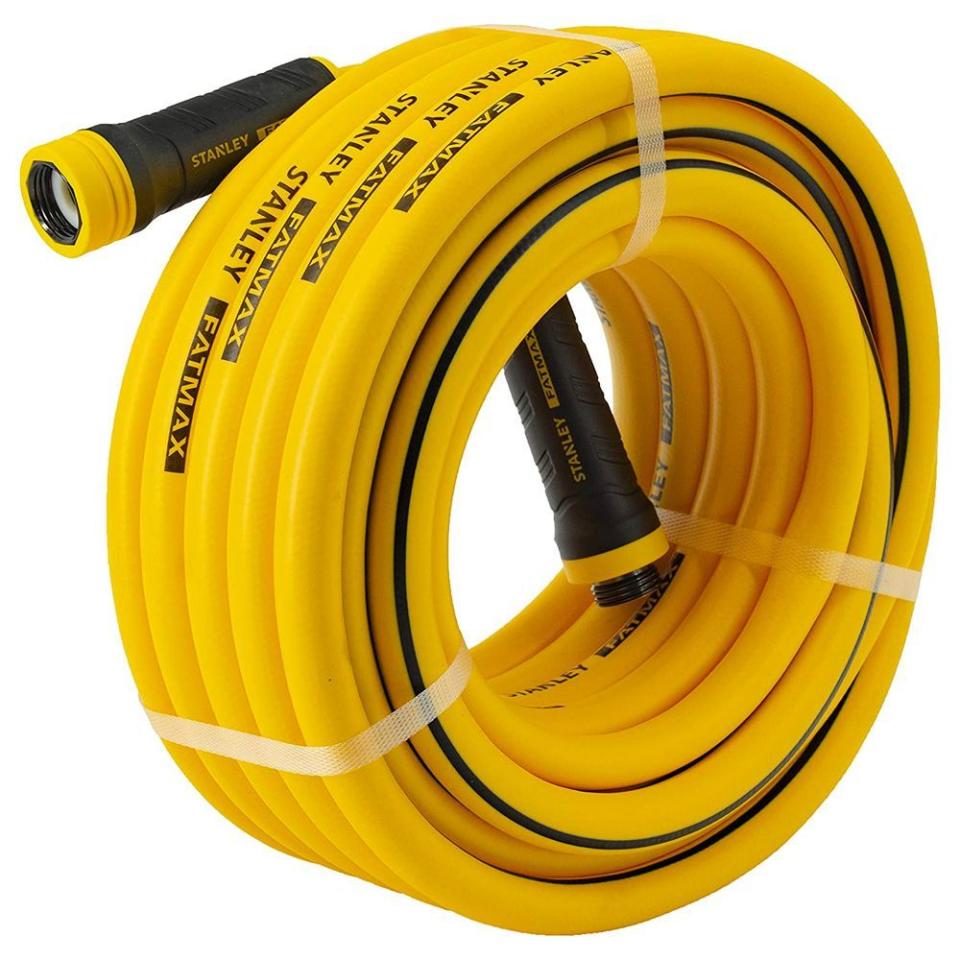
Fatmax
amazon.com
$45.91
Stanley’s Fatmax hose has all the attributes of a professional-quality hose. It has a larger inside diameter to move more water. In fact, at 587.3 gallons per minute, it has the highest flow rate of any ⅝-inch hose we’ve tested. While the hose fittings aren’t marketed as crushproof, the large-diameter swivel grips protected the fittings when we drove over them with a 4,500-pound truck—the swivel grips also make it easy to connect the fittings tightly.
We liked the soft, flexible feel of the polyurethane and PVC hose, as well as the minimal memory it displayed. This made coiling and uncoiling the hose a smooth process. During testing, we found it tends to twist out of tight coils before it kinks. Paying attention and giving the hose a twist often helped it uncoil quicker. A bigger hose does hold more water, so it was no surprise the Fatmax took a little more effort to drag out to full length—on concrete it took 9 pounds of force, while on grass it was a little less, at 8.6 lb.
Stanley’s Fatmax is a good choice for folks who are less concerned about weight and more concerned about durability and moving a lot of water—because of the high flow rate, it would be a good choice to use with a pressure washer.

AG-Lite
amazon.com
$70.20
BluBird’s Ag-Lite rubber hose is about the burliest hose you’ll be able to find. Real rubber hoses tend to weigh a lot more than any other material, but the folks at BluBird managed to reduce this model’s weight by 20 percent compared to other rubber hoses.
The version we tested had a ¾-inch inner diameter, the biggest in this test, which means it holds a lot of water. That makes the hose heavier to handle and drag when filled: It took 15.3 pounds of force to pull it out to full length on grass. On concrete sidewalk, it dragged it a little easier, requiring 12.4 pounds. On the plus side, the hose is heavy because it carries a lot of water. We measured the flow through it at 650 gallons per hour, 17 percent more than the next closest hose in this test. The heavy brass hose fittings are plated with chrome, so they’ll stand up to plenty of abuse.
One notable advantage of rubber hoses is that they remain flexible through a wide temperature range, so that they’re not too stiff in the cold, or too soft in the summer. The Ag-Lite is rated to handle water up to 212°, so it’s good for washing down equipment in the winter or janitorial tasks. If taken care of properly, a rubber hose can last for years, and BluBird is so confident in its durability that it offers a 10-year warranty.

Hybrid Garden Hose
amazon.com
$79.99
Giraffe Tools’ Hybrid hose has solid brass fittings that are plated with nickel, making them corrosion-resistant and almost impossible to bend or crush. The ends also feature strain relief grips, protective plastic collars that help prevent them from kinking or tearing near the fittings. The moveable rubber handgrip not only helps protect the end of the hose, but rotates naturally in your hand, making it easy to connect this hose to a faucet, spigot or another hose.
It’s also a durable hose. It’s made from a hybrid rubber-polymer blend, which is light enough to lug around without too much difficulty, but capable to stand up to the elements. It remains supple, flexible, and easy to move and coil even when temperatures dip below freezing. From the hose itself to its connectors, this one is built to last.

2662-U Classic Garden Hose and Reel
amazon.com
$134.00
Buying a portable hose reel, where the hose comes with a spinning housing, is one of the easiest ways to ensure you can easily move and store your garden hose. We like the Gardena 2662-U because it doesn’t require you to sacrifice length for the sake of storage. At more than 50 feet long, this is all the hose you’re likely to need for projects around the house, but the hose has a tiny footprint when you retract it back into the reel.
It’s surprisingly sturdy for a hose that takes up so little space, and though it’s narrower than a standard garden hose, it comes with a set of adapters so you can use it with any standard spigot.
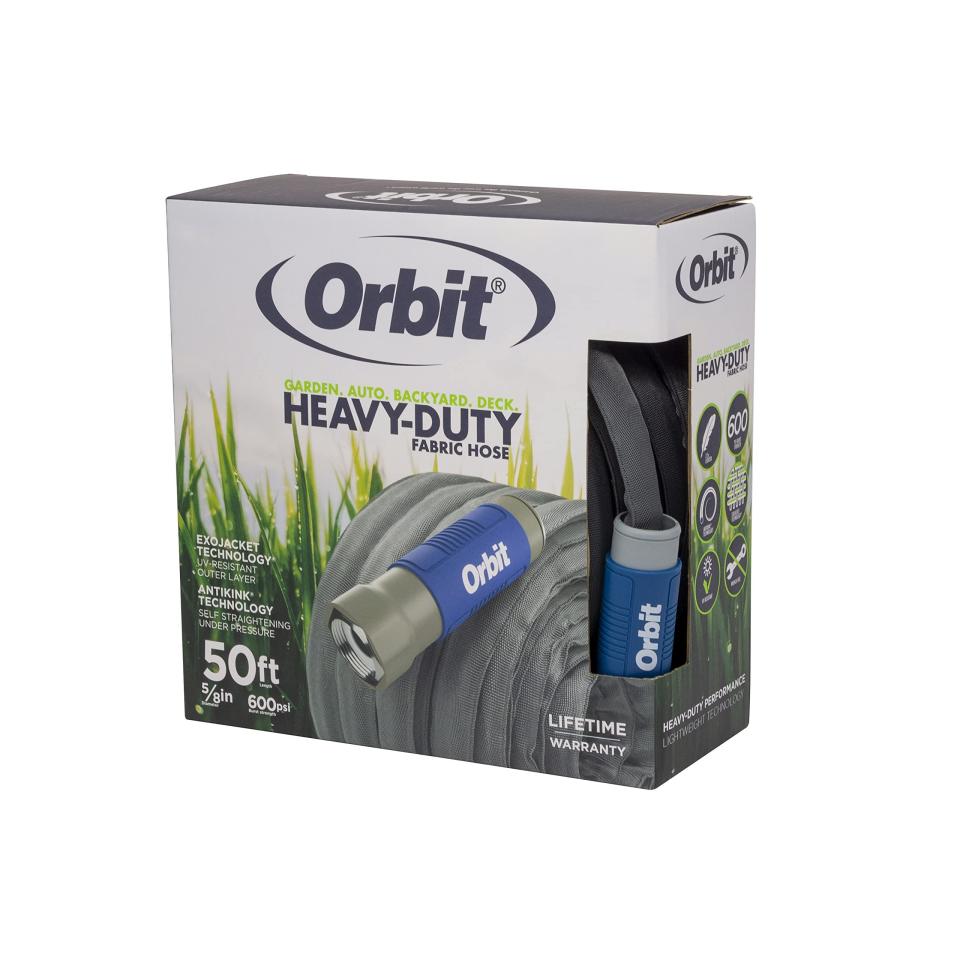
ExoJacket Fabric Garden Hose
amazon.com
$42.79
Orbit’s Fabric Garden Hose features “ExoJacket” technology, pairing a woven, UV-resistant outer layer and a flexible inner core to form a collapsible, lightweight hose. When not under pressure, the hose flattens out and can be coiled tightly to store in a fraction of the space of regular hoses. Despite its highly flexible nature, it features an impressive 600 psi burst strength.
In testing, we found the Fabric Garden Hose didn’t kink very easily—although it gets tangled a little easier than traditional hoses. The light hose was easy to drag across most surfaces, but the fabric outer layer could occasionally snag on rough pavement. Its anodized aluminum fittings are embedded in large, easy-grip collars, which made tightening hose connections a breeze. Orbit’s Fabric Garden Hose is great for most watering or washing uses, although it may be most appealing to those who hate dealing with large coils of hose.
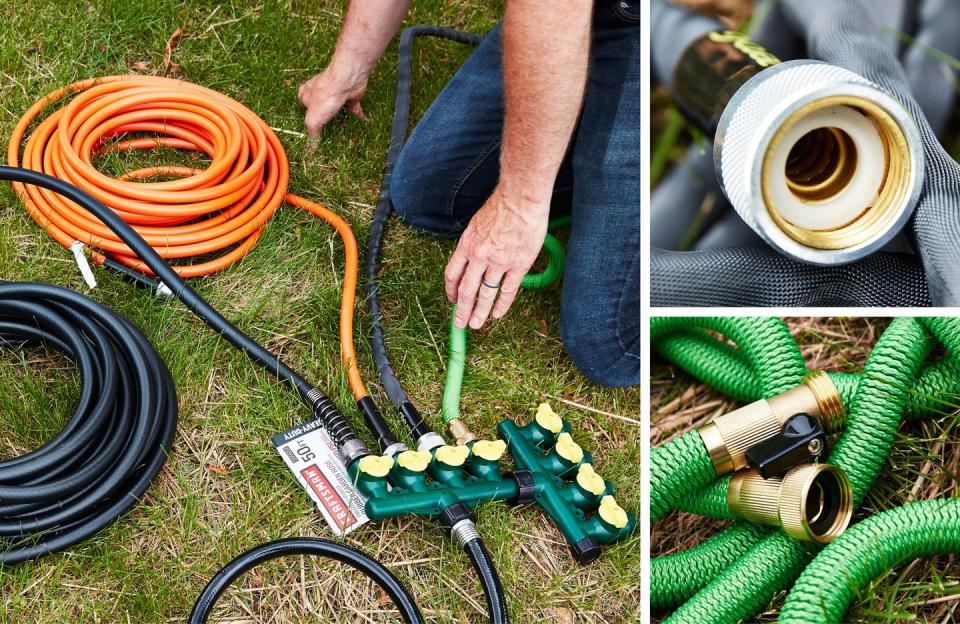
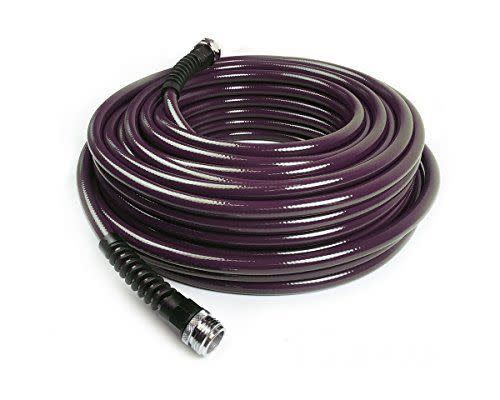
Water Right Garden Hose
amazon.com
$77.96
Gardener’s Water Right Light 75-foot hose earns its name, weighing in at just 5 pounds. It’s optimized for weight by using small ½-inch diameter polyurethane tubing and aluminum fittings. In use, this is evident, dragging it out to full length on grass takes only 4.9 pounds of force and just a little more on concrete, at 5.8 pounds. This makes it convenient to handle in the garden, on the patio, or around raised beds.
Kink resistance is good, and the weight makes it easy to correct or avoid kinks by twisting or flipping the hose. It is intended for garden use, and it is ideal for that, but it is also drinking-water safe, so it could be used for an RV hook-up as well. It could also be used for anything else, although the flow rate isn’t optimal for things that require a large volume of water.

AquaArmor Lightweight Garden Hose
homedepot.com
$40.09
Gilmour’s AquaArmor Lightweight Hose is among the lightest we’ve tested. In fact, only three of the hoses we’ve tested to date have been lighter, but at nearly 400 gallons per hour, the AquaArmor’s flow rate is considerably higher.
Like many manufacturers, Gilmour claims the hose is kink resistant and able to unkink itself. We were able to kink the AquaArmor hose in use, dragging it out from a coil, but we discovered that if pulled taught, kinks would “pop” out. So, if pulled to half-length, kinks could occur and inhibit water flow, but reaching full length, under tension, they disappear. The hose has internal kink protection at both ends to prevent collapse when pulled tight at an angle.
When we tested resistance, dragging the AquaArmor hose to full length across concrete and grass, it fell in the middle of those we tested at 6.7 and 7.3 pounds of force, respectively. Due to its weight and relative ease of handling, the AquaArmor hose is good to use around gardens, patios, and lawns—plus, it’s drinking water safe because it's made from FDA food contact compliant material.
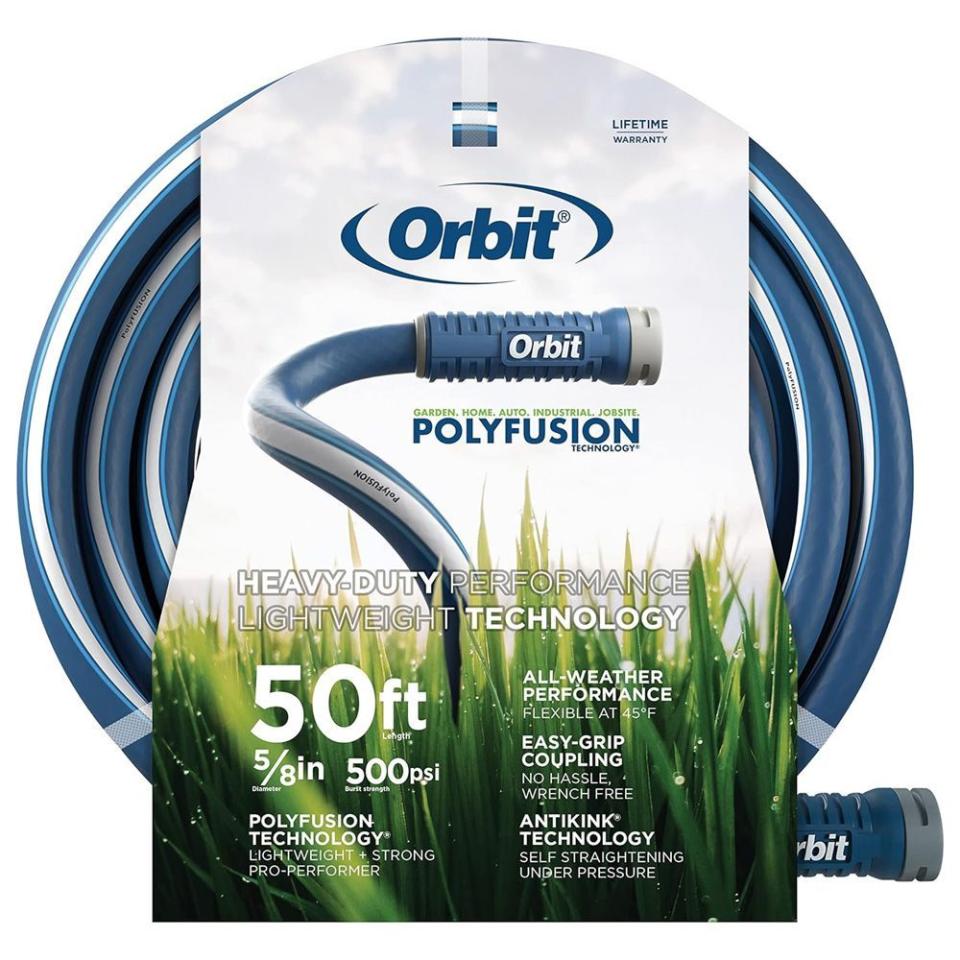
Polyfusion Garden Hose
amazon.com
$46.58
Eschewing the trend of ultra-lightweight hoses, Orbit’s Polyfusion is made from a durable polyurethane/PVC blend that leans toward the heavier side of those we tested. We also found it to be resistant to abrasion, so it should hold up over years of use.
The Polyfusion exhibited minimal memory during testing, which made coiling and uncoiling it easy, and also made it less likely to kink. When moving and pulling the hose under pressure, it has a tendency to self-straighten, twisting itself out of kinks. The Fittings are made of anodized aluminum and connected to strain-relief collars that double as grips that help to easily tighten hose connections.
The Polyfusion is a great hose for gardeners who are looking for high performance and durability, even at the expense of high heft.
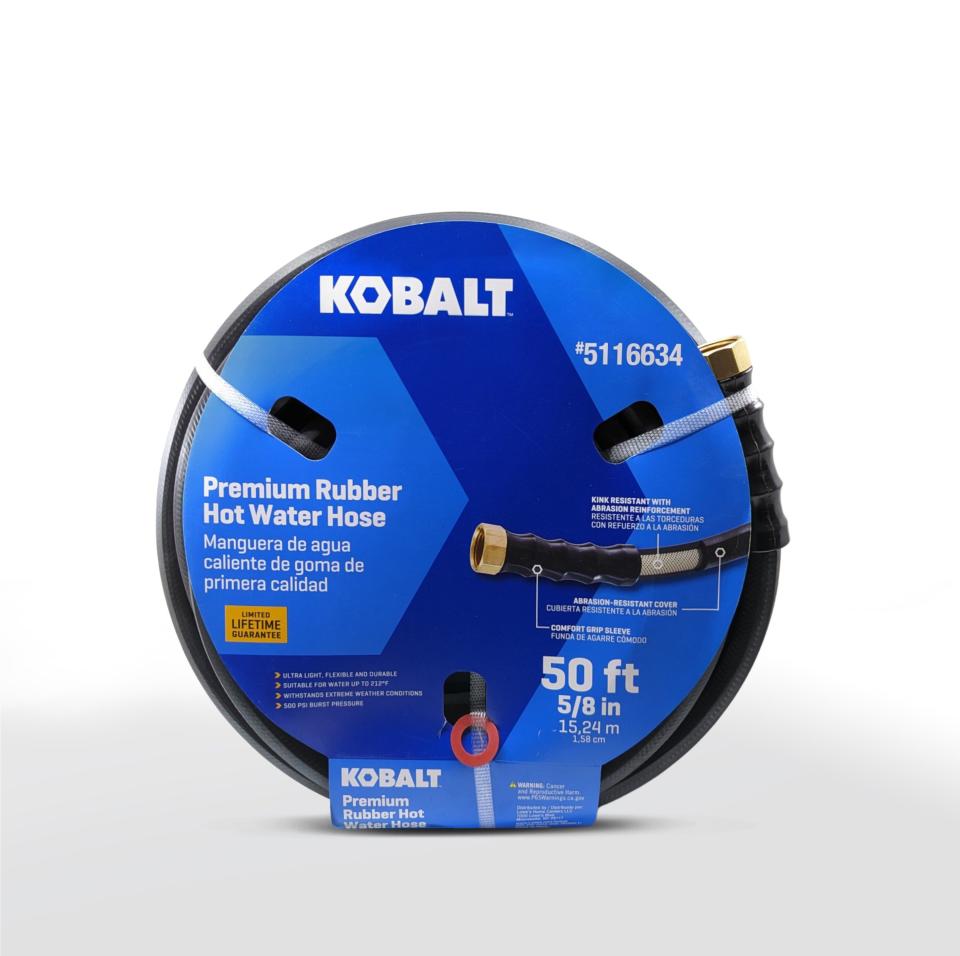
Hot Water Hose
lowes.com
$49.98
If you have to use hot water anywhere away from a faucet or spigot, you’ll need a special hose for that. Many of the synthetic/poly type hoses appreciably soften when they get hot, which can make them weaker—especially under pressure.
Hot water hoses like the Kobalt Hot Water hose are made primarily from natural rubber, which is more stable across a range of practical temperatures. The Kobalt hot water hose specifically adds woven polyester reinforcement and is rated up to 150 psi at 212-degrees F. It’s also fitted with brass hose connectors and comfort grip strain relievers that make tightly threading it onto your spigot a snap.
Watering Tips With Expert Kate Morgan
What length garden hose should I buy?
When buying a new garden hose, you might assume that longer is always better. In fact, you should try to only buy the length you really need for your specific area. If you only need 50 feet–a standard size for consumer hoses–that’s all you should get. A longer hose is harder to coil up and heavier to lug around. Plus, you'll see less water pressure at your nozzle from a longer hose.
If you can generally get by with a shorter hose but you think you might very occasionally need more length to wash your roof or something at the far end of your yard, it may be easier to get two hoses and join them together when you need the extra length, rather than dealing with an unwieldy XL hose all the time.
How do I keep my garden hose in good condition?
A hose is often the tool used to perform maintenance on other things, so you might not think too much about taking care of the hose itself. But hoses need maintenance, too.
To keep yours in good condition, make sure you’re completely draining it of water after every use. Leaving water sitting inside can lead to a build-up of bacteria, which can degrade the hose’s inner lining. It's especially important to fully empty your hose and disconnect it from the spigot in the winter, especially when you’re expecting freezing temperatures. Water expands as it freezes, so a hose full of ice could easily spring a leak.
Exposure to UV light will also degrade plastics and rubbers over time, so try and keep your hose inside or at least in the shade to ensure it lasts as long as possible.
What do I do if my garden hose springs a leak?
Finding a hole in a hose doesn’t automatically mean it’s destined for the dumpster. Small (and even not-small) leaks can be easy to fix. If you’ve made a considerable investment on a high-end model, spending a little time on a repair is worth it.
You can cover most small holes easily with a strip of electrical tape to reseal them. Wrap the tape around a few times to get a good seal, but try not to use so much that you create a trouble spot that will collapse or crimp.
Bigger leaks can be solved with a gadget called a hose mender, which couples two ends of the hose back together. You can cut out the damaged section of hose, then use the mender to put the ends back together. As long as you’ve installed it correctly, your hose should be good as new.
You Might Also Like

